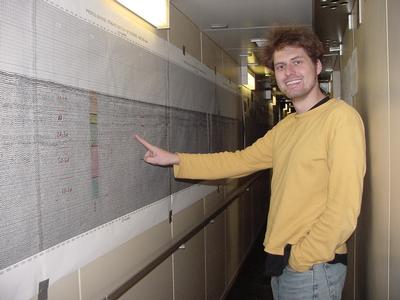14 September, 2001
A Day Abroad
Today was a wonderful day aboard the Polarstern. Yesterday scientist Paul
Schmieder, a student from the University of Tulsa, and I were chosen to
spend some time on the German icebreaker. We had a short 5-minute flight
to reach the ship from the Healy, and upon our arrival a group of
scientists were waiting to welcome us. We each met our roommates and were
taken to our very comfortable and cozy rooms.
The Polarstern and Healy are on different times - the Polarstern's time is
5 hours ahead of the Healy's. This meant that although it was 2:00 pm
when we left the Healy, it was after dinner when we arrived aboard our
neighbor's ship 5 minutes later. Talk about jet-lag! We were given a
grand tour and spent the remainder of the evening in the ship's comfortable
lounge snacking and socializing.
After a good night's sleep, we spent the morning learning about the variety
of Polarstern's science programs. There were many scientists that spent
time with us and patiently explained how their programs work.
The first operation that we observed was the TV Grab. The "TV" is a camera
with 2 lights that are mounted on a metal jaw-like apparatus. It allows
the users to see the ocean floor and "grab" rocks that come into view. We
watched the use of this equipment and saw animals swim by the camera on its
way down and animals crawling on the ocean floor. Unfortunately they were
not in clear focus, and so we could not identify their types. When the
instrument hit bottom, it blasted up a muddy cloud that told the scientists
controlling it that the sea floor was covered with sediment instead of the
rocks they desired. The ship slowly moved and pulled it along the floor
for over an hour, but no rocks were sighted. They ended up grabbing mud
and hauling it to the surface.
Speaking of mud, we learned from a sedimentologist about sediment cores
that are being taken from the Arctic Ocean floor by using an instrument
called a "box core". The sediment is collected in columns and studied. As
you go down in the column, the sediment becomes older, and microfossils
trapped in the layers give you information such as relative age of the
sediment and past climates of the Arctic region. This is a very
interesting job if you like to play in the mud!
We also learned how scientists aboard the Polarstern are mapping the crust
of the Earth. The crust under the Arctic Ocean is mapped in a "seismic"
study. This is where air under high pressure is released to create sound
waves. These waves travel to the seafloor and penetrate into the crust.
The waves reflect back from the crust and are received by the ship where
the data is used to make maps that show crustal structure.
There were many scientists who took time to explain concepts to us today
and we had wonderful hospitality from our German friends on the
Polarstern. Tomorrow we may stay or go. Our fate is in the hands of the
ever-unpredictable Arctic weather.

A German scientist, Anna, stands in front of the TV Grab. The clear-looking tubes on the side are the lights and the metal part grabs rocks. This "grab" has only mud inside.

Oliver, a scientist on the Polarstern, proudly shows us his seismics map of the ocean crust.
Contact the TEA in the field at
.
If you cannot connect through your browser, copy the
TEA's e-mail address in the "To:" line of
your favorite e-mail package.
|
